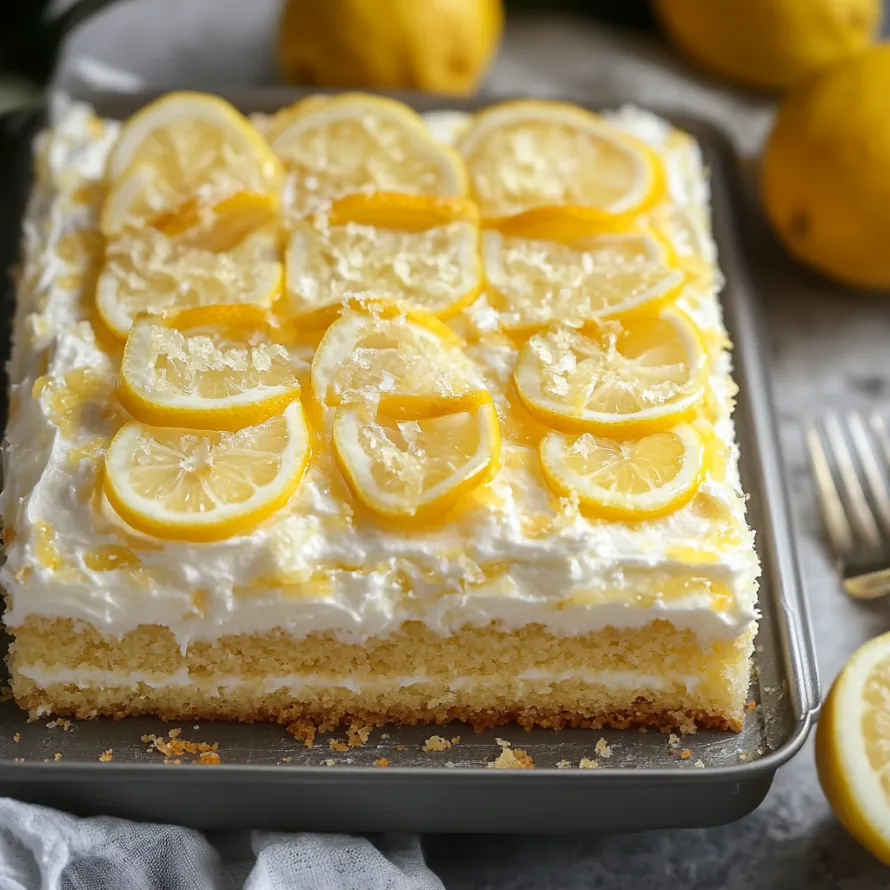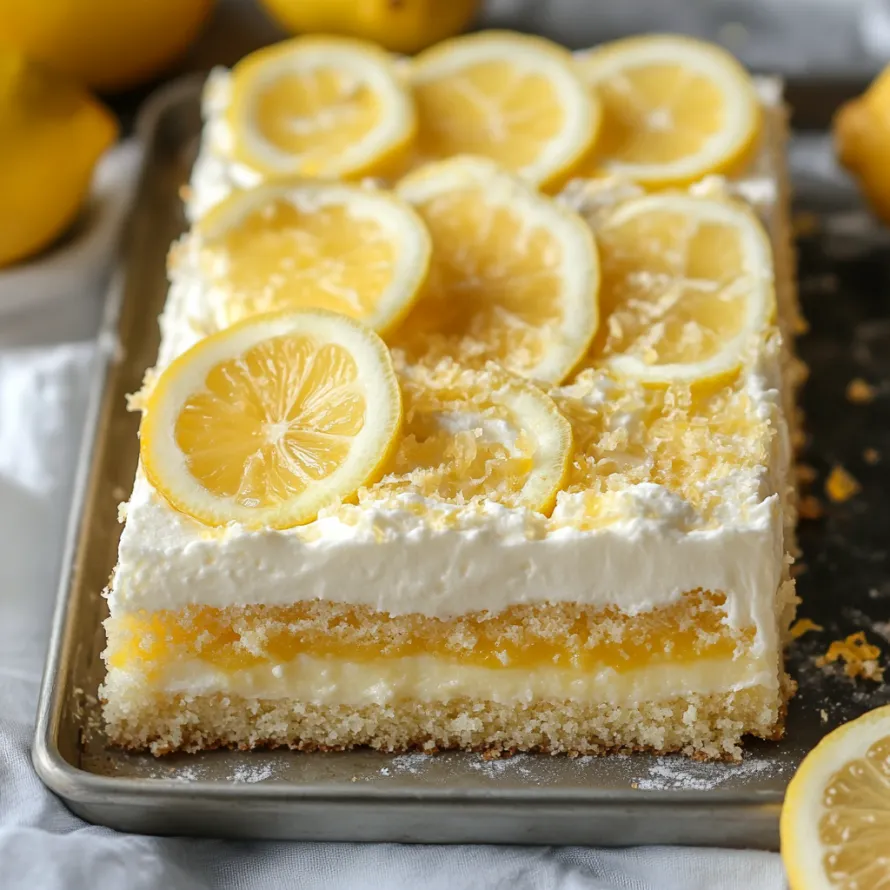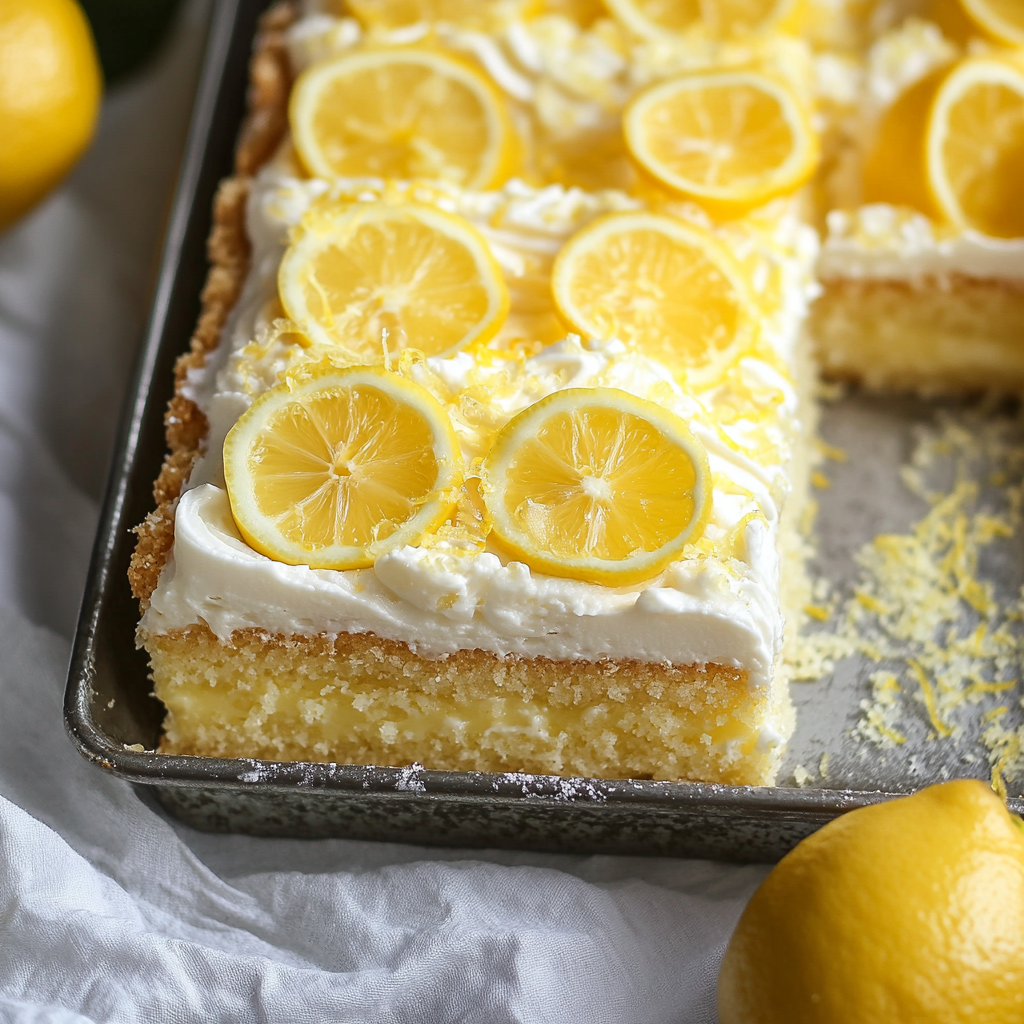 Save
Save
This sheet cake puts a fun spin on traditional lemon bars by turning them into cake form, with a crumbly shortbread base, zesty lemon sponge, tangy homemade lemon filling, and smooth frosting on top. It strikes just the right balance between sweet and sour that'll wow everyone at your next get-together.
I whipped this up for the first time when my sister wanted something lemony but extra special for her birthday. These days it's become our go-to spring celebration dessert, and everybody always argues about who'll get the corner slices with that extra bit of crust.
Ingredients
- Shortbread cookies: They create the buttery foundation and topping that works perfectly with the tart lemon. Go for premium butter cookies to get the tastiest results
- Fresh lemons: You'll need both the outer zest and juice inside. Pick bright yellow ones that seem heavy when you hold them, as they'll have more juice
- Buttermilk: Makes the cake super soft. Don't forget to let it sit out until it reaches room temp for better mixing
- Lemon cake mix: Helps you save time but still lets you add your personal touch. Duncan Hines tends to work the best
- Egg yolks: They give the lemon filling its luxurious texture. You can save the whites for something else
- Unsalted butter: Lets you decide how much salt goes in. European styles with higher fat make everything taste better
- Lemon extract: Boosts the citrus flavor. You can skip it, but it really pumps up the lemon taste if you use it
Step-by-Step Instructions
- Prepare the Shortbread Crust:
- Crush those shortbread cookies into tiny crumbs, then stir in the melted butter and salt. You'll know it's right when it clumps together if you squeeze it but still feels a bit crumbly. Push it down hard into your pan with a flat measuring cup to make a solid layer that won't fall apart when you cut it later.
- Create the Lemon Cake Layer:
- Mix your wet stuff first, then add the dry things. Using room temp ingredients helps everything blend smoothly and rise evenly. Don't overmix once you add the cake mix or you'll end up with a tough cake. The extra flour and rising agents we add help support the weight of that crust.
- Make Homemade Lemon Curd:
- Keep stirring non-stop so the eggs don't cook too quickly. There's a magic moment about 6 minutes in when it suddenly gets thick. Run it through a strainer to catch any cooked egg bits and the zest, leaving you with a smooth, silky filling. Put plastic wrap touching the surface to keep a skin from forming on top.
- Prepare the Lemon Buttercream:
- Start with softened butter for the best results. Add your powdered sugar little by little until it feels right. The heavy cream makes it silky smooth while the flavors come from the extracts. Whip it fast to get air in for lightness, then slow down to pop those big air bubbles so it pipes more smoothly.
- Assemble the Cake:
- Spread that buttercream flat with an angled spatula. Pipe pretty rows to make little valleys for the lemon filling. Carefully pour the filling into these channels, making sunny yellow puddles. Top it off with crumbled shortbread for a nice crunch and pretty look.

The lemon filling really steals the show in this treat. I learned how to make it during a cooking class back in culinary school when our teacher showed us how a few simple things can turn into something amazing with gentle heat and some patience. My family now asks for jars of this stuff as gifts during the holidays.
Make Ahead Friendly
This cake works great for planning ahead. You can make the lemon filling up to a week before and just keep it in the fridge in a sealed container. The cake part can be baked a day early and left wrapped up at room temp. It's best to put everything together within a few hours of when you'll serve it for the freshest look, but the whole cake will stay good in the fridge for up to 4 days.
Customization Options
You can switch things up easily to match what you like or fit different occasions. Try using graham crackers instead of shortbread for the crust. Switch lemon for orange or lime if you want a different citrus flavor. For fancier events, cut it into small squares and top each with a tiny edible flower or mint leaf. During holidays, add some festive sprinkles or colored sugar that matches the season.
Serving Suggestions
This cake tastes great by itself, but it's also amazing with fresh berries, especially raspberries or blueberries that go so well with lemon. A spoonful of lightly sweetened whipped cream next to each slice looks and tastes wonderful. If you want something more indulgent, serve it slightly warm with a small scoop of vanilla ice cream. During summer parties, I love to pair it with mint iced tea for a really refreshing combo.

This cake brings a burst of sunshine to any table. Grab a slice and watch faces light up with every tangy, sweet bite.
Common Recipe Questions
- → Can the lemon curd be prepped early?
Absolutely, you can make the lemon curd up to three days ahead. Keep it sealed in the fridge with wrap touching the top to stop a skin forming. Since the curd needs to be chilled anyway, an early prep works well.
- → What cookies suit the crust best?
Pick plain shortbread cookies like Walkers or Lorna Doone for the job. Steer clear of those with chocolate or fillings. You'll need cookies to yield about 3 cups of crumbs—roughly 11 to 15 ounces total, depending on their density.
- → Any swaps for lemon cake mix?
Though Duncan Hines is the favorite, feel free to use another lemon mix. If unavailable, use white or yellow cake mix, adding 2 tsp of lemon extract and some extra grated lemon peel for added zing.
- → What’s the best way to store leftovers?
Put leftover cake in an airtight container in the fridge. It’ll stay fresh for up to 4-5 days. Since the curd has butter and eggs, it’s vital to keep it cold. Pull slices out 20 minutes early for better flavor and texture when serving.
- → Can I freeze it for later?
You can freeze only the base and cake layers before adding frosting or curd. Wrap tightly with plastic wrap, then foil, and store for a month max. Let it thaw completely in the fridge before decorating. Once assembled with frosting and curd, freezing is not recommended as the textures might suffer after thawing.
- → How thick should I make the crust?
A thickness of about 1/4 inch works perfectly for the shortbread crust. Press it evenly and firmly into the pan using a glass bottom or measuring cup to make sure it holds together when sliced.
